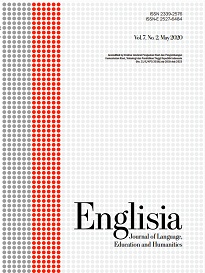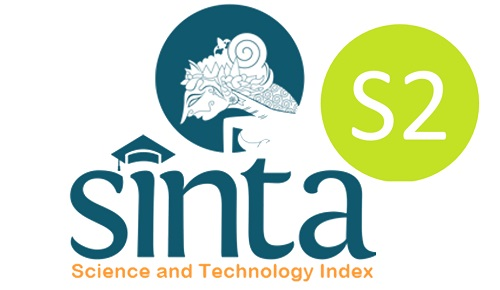Elements of critical reading in EFL teachers’ instructions
DOI:
https://doi.org/10.22373/ej.v10i2.17142Keywords:
critical reading, EFL teachers, reading instructions, elements of critical readingAbstract
Reading instructions should go a bit beyond ‘explicit question’ to facilitate students’ critical thinking. What it means by ‘explicit question’ is question whose answer can be found in the text explicitly. This research, therefore, aimed to investigate EFL teachers’ reading instructions to find out to what extend the instructions contained the elements of critical reading. Twenty-seven EFL teachers participated by listing all the activities they had given to students throughout their teaching career. All the activities were collected, and similar activities were combined. There were a total of ninety-nine instructions. The activities were then compared to critical reading framework to find out which elements they belonged to. Findings showed that teachers’ reading instructions only belonged to such categories as identifying, analyzing, summarizing, and guessing. Aside from that, the instructions for the four categories were the same. It appeared that EFL teachers lacked creativity and innovative ideas. There were still elements or categories of critical reading that had not yet been utilized or explored. These findings prompted the inclusion of critical reading instruction design skills in teacher education. After all, critical thinking has long been emphasized in national education as a means of developing responsible citizens and avoiding becoming a victim of false information.
Downloads
References
Ahmad, S. Z. (2019). Impact of cornell notes vs. REAP on EFL secondary school students' critical reading skills. International Education Studies, 12(10), 60-74.
Akın, F., Koray, Ö., & Tavukçu, K. (2015). How effective is critical reading in the understanding of scientific texts?. Procedia-social and behavioral sciences, 174, 2444-2451.
Albeckay, E. M. (2014). Developing reading skills through critical reading programme amongst undergraduate EFL students in Libya. Procedia-Social and Behavioral Sciences, 123, 175-181.
Al-Kalefawi, Z. M., & Al-Amrani, S. N. (2021). Enhancing reading strategies of Arab EFL students using I-CARE program: A case study. Computer-Assisted Language Learning, 22(1), 414-431.
Arifin, S. (2020). The role of critical reading to promote students’ critical thinking and reading comprehension. Jurnal Pendidikan Dan Pengajaran, 53(3), 318-326.
Carillo, E. C. (2019). Navigating this perfect storm: teaching critical reading in the face of the common core state standards, fake news, and google. Pedagogy: Critical Approaches to Teaching Literature, Language, Composition, and Culture, 19(1), 135-159.
Dabarera, C., Renandya, W. A., & Zhang, L. J. (2014). The impact of metacognitive scaffolding and monitoring on reading comprehension. System, 42, 462-473.
DiYanni, R. (2017). Reading responsively; reading responsibly: An approach to critical reading. In Robert DiYanni, & Anton Borst (Eds.), Critical reading across the curriculum, vol. 1, the humanities (pp. 3-23). Hoboken, NJ: Wiley Blackwell.
Fadhillah, A. M. (2017). Embedding critical thinking through critical reading: Teaching narrative text in junior high school. Journal of English and Education, 5(2), 92-102.
Fatemeh, K., Mahmoud, A., & Roman, K. (2020). Using interactive e-based flipped learning to enhance EFL literature students’ critical reading. Science for Education Today, 10(1), 25-42.
Florea, N. M., & Hurjui, E. (2015). Critical thinking in elementary school children. Procedia-Social and behavioral sciences, 180, 565-572.
Hassan Taj, I., Ali, F., Sipra, M., & Ahmad, W. (2017). Effect of technology enhanced language learning on EFL reading comprehension at tertiary level. Arab World English Journal (AWEJ), 8(1), 108-129.
Kakvand, R., Aliasin, S. H., & Mohammadi, E. (2022). Combined and differential effects of top-down and bottom-up reading processes on target vocabulary learning and retention by EFL learners. Reading Psychology, 43(5-6), 405-422.
Karadağ, F., Demirtaş, V. Y., & Yıldız, T. (2017). Development of critical thinking scale through philosophical inquiry for children 5-6 years old. International Online Journal of Educational Sciences, 9(4). 1025-1037.
Kendeou, P., Van Den Broek, P., Helder, A., & Karlsson, J. (2014). A cognitive view of reading comprehension: Implications for reading difficulties. Learning Disabilities Research & Practice, 29(1), 10-16.
Khabiri, M., & Pakzad, M. (2012). The effect of teaching critical reading strategies on EFL learners’ vocabulary retention. The Journal of Teaching Language Skills, 4(1), 73-106.
Kim, H. (2020). The efficacy of Zoom technology as an educational tool for English reading comprehension achievement in EFL classroom. International Journal of Advanced Culture Technology, 8(3), 198-205.
Kusumaningputri, R. (2019). Responding to Islamic religious conducts: Situating morality through critical reading literacy task on cartoons for Indonesian EFL Muslim learners. Indonesian Journal of Applied Linguistics, 9(1), 210-218.
Linderholm, T., Virtue, S., Tzeng, Y., & Van den Broek, P. (2018). Fluctuations in the availability of information during reading: Capturing cognitive processes using the landscape model. In Discourse Processes (pp. 165-186). Routledge.
Marschall, S., & Davis, C. (2012). A conceptual framework for teaching critical reading to adult college students. Adult learning, 23(2), 63-68.
Marie-France, D., & Mathieu, G. (2012). Pupils’ age and philosophical praxis: Two factors that influence the development of critical thinking in children. Childhood & Philosophy, 8(15), 105-130.
Masoud, A., & Mostafa, H. (2020). Implementing Generative Learning Model to enhance 2nd year English majors’ critical reading and writing skills. Journal of Research in Curriculum Instruction and Educational Technology, 6(1), 115-148.
Mohammadian, A., Saed, A., & Shahi, Y. (2018). The effect of using video technology on improving reading comprehension of Iranian intermediate EFL learners. Advances in Language and Literary Studies, 9(2), 17-23.
Nilson, C., Fetherston, C. M., McMurray, A., & Fetherston, T. (2013). Creative arts: An essential element in the teacher's toolkit when developing critical thinking in children. Australian Journal of Teacher Education. 38(7), 1-17.
Ovilia, R., & Asfina, R. (2022). The power of pleasure reading: A narrative inquiry of proficient non-English Learners. JEES: Journal of English Educators Society, 7(2), 173-181.
Park, J. (2015). Integrating reading and writing through extensive reading. ELT Journal, 70(3), 287–295.
Qizi, R. D. T., & Qizi, M. F. M. (2021). Developing the critical thinking of primary school students. ACADEMICIA: An International Multidisciplinary Research Journal, 11(10), 769-772.
Rajabi, P., & Tabatabaee, M. S. (2015). The impact of teaching critical reading strategies on the development of critical reading ability of Iranian EFL learners. Journal of Applied Linguistics, 1(1), 75-90.
Ross, C. S. (2021). Making choices: What readers say about choosing books to read for pleasure. In Readers, reading and librarians (pp. 5-21). Routledge.
Soomro, A. H., Khan, I., & Younus, M. (2019). Top down, bottom up and classroom reading anxiety and their effect on reading performance of undergraduate engineering students in Pakistan. Journal of Applied Research in Higher Education, 11(3), 590-603.
Suk, N. (2016). The effects of extensive reading on reading comprehension, reading rate, and vocabulary acquisition. Reading Research Quarterly, 52(1), 73–89.
Sullivan, A., & Brown, M. (2015). Reading for pleasure and progress in vocabulary and mathematics. British Educational Research Journal, 41(6), 971-991.
Sunggingwati, D., & Nguyen, H. T. M. (2013). Teachers' questioning in reading lessons: A case study in Indonesia. Electronic Journal of Foreign Language Teaching, 10(1). 80-95
Suraprajit, P. (2019). Bottom-up vs top-down model: The perception of reading strategies among Thai university students. Journal of Language Teaching and Research, 10(3), 454-460.
Utami, R. D., Amalia, N., Prayitno, H. J., & Ain, D. Q. (2020). Critical reading skills through multimodal text to upper-class students in elementary school. International Journal of Innovation, Creativity and Change, 11(5), 125-137.
Wanzek, J., Vaughn, S., Scammacca, N. K., Metz, K., Murray, C. S., Roberts, G., & Danielson, L. (2013). Extensive reading interventions for students with reading difficulties after grade 3. Review of Educational Research, 83(2), 163–195.
Wexler, J., Swanson, E., Kurz, L. A., Shelton, A., & Vaughn, S. (2020). Enhancing reading comprehension in middle school classrooms using a critical reading routine. Intervention in school and clinic, 55(4), 203-213.
Widowati, D. R., & Kurniasih, K. (2018). Critical reading skill and its implication to speaking ability in multicultural classroom. Celtic: A Journal of Culture, English Language Teaching, Literature and Linguistics, 5(2), 18-23.
Yamashita, J. (2013). Effects of extensive reading on reading attitudes in a foreign language. Reading in a Foreign Language, 25(2), 248-263.
Yang, Y., Tsai, Y. R., & Hikaru, Y. (2019). Top-down and bottom-up strategy use among good and poor readers in EFL reading comprehension. European Journal of English Language Teaching, 4(3), 101-114.
Zhussupova, R., & Kazbekova, M. (2016). Metacognitive strategies as points in teaching reading comprehension. Procedia-social and Behavioral Sciences, 228, 593-600.
Downloads
Published
Issue
Section
License
Proposed Policy for Journals That Offer Open Access
Authors who publish with Englisia journal agree to the following terms:
- Authors retain copyright and grant the journal right of first publication with the work simultaneously licensed under a Creative Commons Attribution License that allows others to share the work with an acknowledgement of the work's authorship and initial publication in this journal.
- Authors are able to enter into separate, additional contractual arrangements for the non-exclusive distribution of the journal's published version of the work (e.g., post it to an institutional repository or publish it in a book), with an acknowledgement of its initial publication in this journal.
- Authors are permitted and encouraged to post their work online (e.g., in institutional repositories or on their website) prior to and during the submission process, as it can lead to productive exchanges, as well as earlier and greater citation of published work (See The Effect of Open Access).









